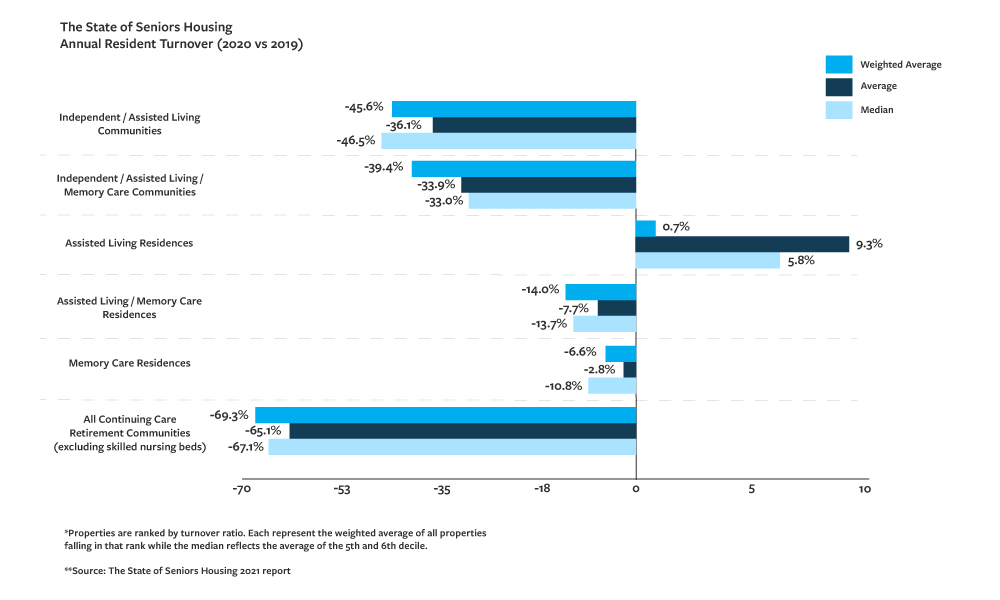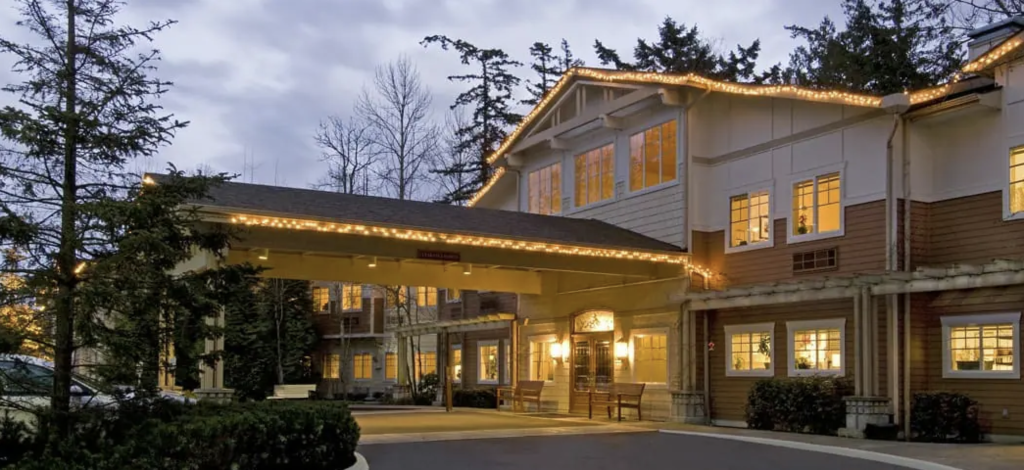Length of stay has long been a top focus for senior living operators — and never more so than today, as they seek to reverse trends caused by the Covid-19 pandemic.
In the years leading up to the pandemic, average length of stay in assisted living was thought to be about 22 months, according to a national study of long-term care providers from the U.S. National Center for Health Statistics (NCHS). But the pandemic’s pressures drove down length of stay in many communities across the country, particularly in assisted living and memory care settings where residents are already higher-acuity.
One recent estimate from Senior Services of America put the national average closer to one year — and other operators have reported similar compressions of average length of stay in the age of Covid.
The reasons why LOS dropped are clear. Move-ins and fears over the pandemic in 2020 led many residents and their families to put off a move into senior housing. At the same time, hospitals began delaying check-ups and elective surgeries and some families opted to move their loved ones back home. So, as move-ins have again picked up, some residents are moving into senior living communities later than they would have in the past, while older and in frailer condition. That increases their likelihood of leaving the community sooner by moving to another care setting or dying.
Now in early 2022, operators including Aegis Living, Frontier Management and ALG Senior are keenly focused on growing length of stay through a variety of strategies that include offering more wellness services and primary care offerings.
Frontier, for example, has partnered with a national rehab company and is offering more robust telehealth, programming and care services to help residents live in the community longer — strategies that are helping to turn the tide in length of stay.
Aegis Living has undertaken similar efforts with its residents, and CEO Dwayne Clark believes the needle will head in the right direction in the months or years to come.
“I think length of stay is going to go back to normal,” Clark told Senior Housing News. “I don’t know if it’s going to be in 2022, but I feel like we’re getting back to normal.”
The state of stays
Much of the data regarding how the pandemic has affected length of stay in 2021 and into 2022 is still being tallied. But there is some anecdotal evidence to suggest length of stay did indeed fall in many parts of the industry.
In 2020, resident turnover actually fell in most senior living settings as communities worked hard to keep the residents they had while move-in restrictions took effect, according to data from the 2021 State of Seniors Housing Report, which is a collaborative research project from the American Seniors Housing Association (ASHA), Argentum, LeadingAge, National Center for Assisted Living (NCAL) and the National Investment Center for Seniors Housing and Care (NIC).
 The State of Seniors Housing 2021 report
The State of Seniors Housing 2021 reportBut today, many residents are still delaying moving in and arriving in need of more care — likely because they delayed a lot of medical procedures and doctor visits, according to what senior living operators have told Colleen Blumenthal, who compiles data for the State of Seniors Housing report. Blumenthal is COO and Partner at HealthTrust.
While Blumenthal said she plans to begin collecting 2021 length of stay data soon, she has heard from operators that some traditional assisted living referrals are fewer than they were before, likely due to independent living communities being more successful in helping residents age in place.
“[That] is also drying up referrals in addition to causing frailer new residents when they finally can no longer manage IL with home health support,” Blumenthal told SHN, relaying what an executive director recently told her.
At Bellevue, Washington-based Aegis, length of stay dropped to about 18 months in 2021 from roughly 27 months before the pandemic. Resident isolation, move-in restrictions and depleted wellness levels were big reasons why, according to Clark. Aegis operates a portfolio of 34 communities.
ALG Senior, which has about 130 assisted living communities in the Southeast, also saw its length of stay compress somewhat with the pandemic, going from between 23 and 24 months before the pandemic to about 20 now, CEO Charlie Trefzger told SHN in December.
“Our census growth right now is all need-driven, even at our more premier facilities,” Trefzger said.
Since the pandemic began, the median age of residents at Five Star Senior Living (NYSE: FVE) has increased, while average length of stay has gone down, CEO Katie Potter said on the company’s third-quarter 2021 earnings call.
“The median age of our resident has steadily increased while the average length of stay is decreasing, resulting in incremental resident turnover,” Potter said. “This dynamic not only impacts the growth and consistency of our revenues, but also drives additive unit costs and marketing expenses.”
Elite Patient Care — a physicians group with more than 250 physicians and advanced practice providers that works with AllyAlign — has found that length of stay sits at about 24 to 30 months for the assisted living communities they work in, and about 12 to 18 months for memory care.
While Elite Patient Care Executive VP of Operations Michael Emery said “there has not been a good study to measure any change in length of stay in these places of service,” he added that the company’s partners have not noticed a significant change in length of stay.
“We have seen an upward trend for improved ‘next site of care selection,’ specifically in the ALs,” Emery told SHN. “Many hospitals are bypassing SNFs to admit patients to a lower cost setting such as an AL — you may have seen programs such as Hospital at Home and other efforts to deliver lower cost care with similar/better outcomes.”
Operator strategies
In the effort to increase length of stay, some operators have implemented strategies to enhance residents’ health and wellness..
For example, Frontier has worked to bring in more health care services funded through Medicare Advantage (MA) and facilitated through telehealth. The operator is also now aligned with Adaptive Rehab, a company that provides rehabilitation for senior living residents. Frontier is also working with AFC Diagnostics for laboratory and testing services.
“We’re taking it to another step,” Roderick told SHN. “We want to make sure we have all the opportunities for our residents to do extremely well, stay as long as possible and stay as healthy as possible.”
Another large operator that has leaned on rehab services to improve length of stay is Five Star, which has a rehab and wellness service line called Ageility. Prior to the pandemic, adding rehab services helped improve average length of stay by about 31% compared to a similar community without a clinic.
“There is a lot of value that the Ageility product brings to a senior living community in terms of length of stay as well as … positively impacting clinical quality measures,” Potter said during the operator’s 3Q call last year.
Aegis is another company focused on resident wellness, and Clark believes that those kinds of services, plus hard-won clinical expertise amid the pandemic, will help improve length of stay down the road.
For ALG, increasing length of stay in 2022 is a “critical focus,” Trefzger said. The company aims to achieve that by boosting care coordination within its communities to improve resident wellness. ALG also is launching a Medicare Advantage plan in 2023.
“We’ve created a certified provider network,” Trefzger said. “That means our primary care practitioners … are given house rules by our chief medical officer, Kevin O’Neil, who has provided guidance as a gerontologist about his expectations on the things that they are supposed to do.”
Another key part of ALG’s length of stay efforts is the way it uses technology. The company uses MatrixCare EHR to track resident data, and plans to partner with a hospital system in Nevada to pilot a resident remote monitoring and support system.
“That is how you have to increase your length of stay,” Trefzger said. “You have to use technology, you have to use human observation and you have to use intervention.”
Companies featured in this article:
Aegis Living, ALG Senior, AllyAlign, Elite Patient Care, Five Star Senior Living, Frontier Management, HealthTrust


